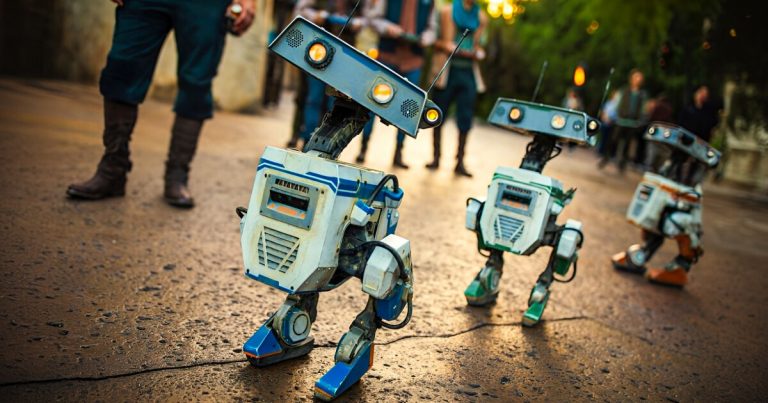The Disney Research Hub has different priorities than other robotics developers: their robots need to work effectively and efficiently, but they also need to be full of style and personality. This super cute bipedal robot based on the BD-1 droid is a perfect example of that.
BD-1 first appeared in the fantastic video game Star Wars: Jedi: Fallen Order, released in 2019. This bird-like, bipedal robot, like many of the robots in Star Wars, is a curious, courageous little character who communicates primarily through R2D2-like beeps and bloops. Residing on the protagonist’s shoulder most of the time, BD was a cheery, helpful companion.
The robot is also very expressive and has the ability to communicate a lot through body language, which posed a major challenge to Disney’s robotics engineers as they tried to bring the little droid to life.
He walks like a bird, but he can definitely act like a dog when it suits him.
Disney Research
As we discussed in October 2023, the Disney Research team designed a new type of motion control system for this little buddy, combining expressive animations with practical robotics considerations like balance and control commands to help him get the job done with style.
This isn’t just for entertainment: Disney, having been at the forefront of the animation movement for decades, rightly recognizes that it has more or less the authority on how all manner of machines should move to convey a range of character traits, from the inquisitive, optimistic excitement embodied in BD-1, to the intimidating physical menace of Darth Vader, to the fluid grace of Snow White.
By designing robotic motion systems where function and form are equally prioritized, Disney hopes to develop robots that behave incredibly naturally around humans, building trust and connection through body language alone.
In a new video released a few days ago, the Disney Research team shows off the current state and capabilities of their BD-1 lookalike robot, and also demonstrates a remote control system that allows them to control the robot’s movements and manipulate its expressive abilities in real time.
Design and control of bipedal robotic characters
It’s amazing how smoothly this robot blends artistic intent with the practicality of bipedal walking, and how beautifully this little character is embodied in this real-world robot. It’s certainly a refreshing change from the ruthless, rigid pragmatism of most of the cutting-edge general-purpose robots we’ve seen over the past few years. Disney may be on the verge of creating an incredibly fascinating machine that will touch the human heart more than any robot on the market in the near future.
What’s noteworthy in the new video is the robot’s ability to maintain its “personality” while walking across a variety of uneven and messy surfaces, which is just a good thing since it seems unable to get up after falling over. Towards the end of the video, we see it all come together in a few demonstration performances, including human interaction. It’s hard not to feel a bit attached to this robot.
Personality is at the heart of every move in this BD-1 style robot
Disney Research
Disney has yet to reveal what they have planned for these robots. They are certainly some of the most amazing animatronic installations we’ve ever seen and will no doubt one day feature in a live-action Star Wars show or movie. Likewise, if they can withstand the rigors of walking around for long periods of time and interacting with crowds, they’ll be hugely popular among Disneyland visitors.
But more importantly, Disney has found a way to apply their animation expertise to the real world, bringing beauty to movement without sacrificing function and practicality, and it will be exciting to see where this concept goes in the coming years.
Source: Disney Research


